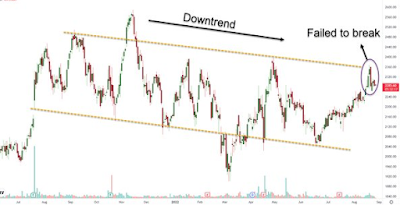Fundamental and technical analysis are two common methods that investors and traders use to predict the future movement of a particular stock. Technical analysis is a method of predicting the future performance of a stock by studying its past performance. While fundamental analysis is one of the most effective ways to determine the long-term movement of a stock, technical analysis provides a similar tool for short-term traders.
Technical analysis is one of the most common methods that traders use to help identify potential trading opportunities. Technical analysis can act as a compass and anchor to help traders better navigate trading decisions. Some of them are described below-
 |
| Is technical analysis enough for trading? |
Support for efficient and quick decision-making: Since most traders buy stocks and sell them on the same day (or vice versa), they need to make quick decisions on buying and selling prices. In such situations, technical analysis is the only type of research that can provide traders with some idea about the stock price direction. There are several automated tools available today that can extract technical information as per your preference.
Helps in Formulating Derivative Strategy: Technical charts enable us to optimize our derivative strategy. When momentum is positive, long futures and calls work better to play the more decisive trend. Conversely, when momentum is negative, investors are persuaded to adequately hedge their long positions in the cash market. When market momentum indicates volatility without a clear direction, strategies like straddles and strangles on the long side come into play. A contrarian approach works better when there is likely to be market capping. Market momentum and support and resistance levels are important information in mapping out a derivative strategy that traders can adopt to make the most of stock market trends.
Technical analysis accurately captures trends and momentum: There are different types of trends in the market. For example, if the market is trending upward you should use every dip as a buying opportunity. Conversely, if the market is trending downward, every rise is a selling opportunity. But how do you determine if a trend is positive or not? This is the moment where speed reading will come in handy.
It indicates a volatility pattern: The most important assumption made when doing technical analysis is that the stock price follows a trend and that the trend repeats itself in a logical pattern. Although identifying these patterns can be complicated at times, it helps traders get a feel for the short-term fluctuations that stocks experience and predict future movements in stock prices.
Is there any difference between trading and share marketing?
Stock markets have existed throughout history in some shape or form. Back in the day, businessmen walked around coffee shops and placed orders in person. These stocks were written by hand! Unlike today's stocks that you can buy and sell from the comfort of your home.
 |
| Is technical analysis actually useful? |
Traders will shout across the trading floor (hereafter technically called the open cry method) and announce the number of stocks they wish to sell or buy. Prices will go up or down depending on the market forces of supply and demand.
After the dematerialization wave, all shares are now held electronically in demat accounts. Traders and investors who once carried briefcases full of carefully stored share certificates can now be found glued to their chairs, staring at multiple screens running the latest trading software. Help them keep an eye on the pulse of the market.
A stock market is a platform for investing in corporate bonds, government bonds, debt instruments, etc. in addition to trading in shares of publicly traded corporations. The main place where you can directly invest in company shares is the equity market. Future. The secondary market where you can trade futures and options is called the derivatives market. The commodity component of the stock market is another area where you can invest in commodities such as agricultural products, metals and other natural resources.
It is important to keep in mind that the stock market is just a market. The process of buying and selling within the market is called trading. Neither can survive without the other. Trading takes place in the stock market.
Trade can be of different types:
 |
| How important is technical analysis in the stock market |
Buying and selling stocks on the same day is called intraday trading. Intraday trading is often done by investors who want to profit quickly from daily price changes.
Delivery Trading: Delivery trading is the practice of placing a buy order today and holding a stock for a few days or overnight before selling it. These traders are known as swing traders, and they are interested in making money from price changes that occur over a few days.





0 Comments